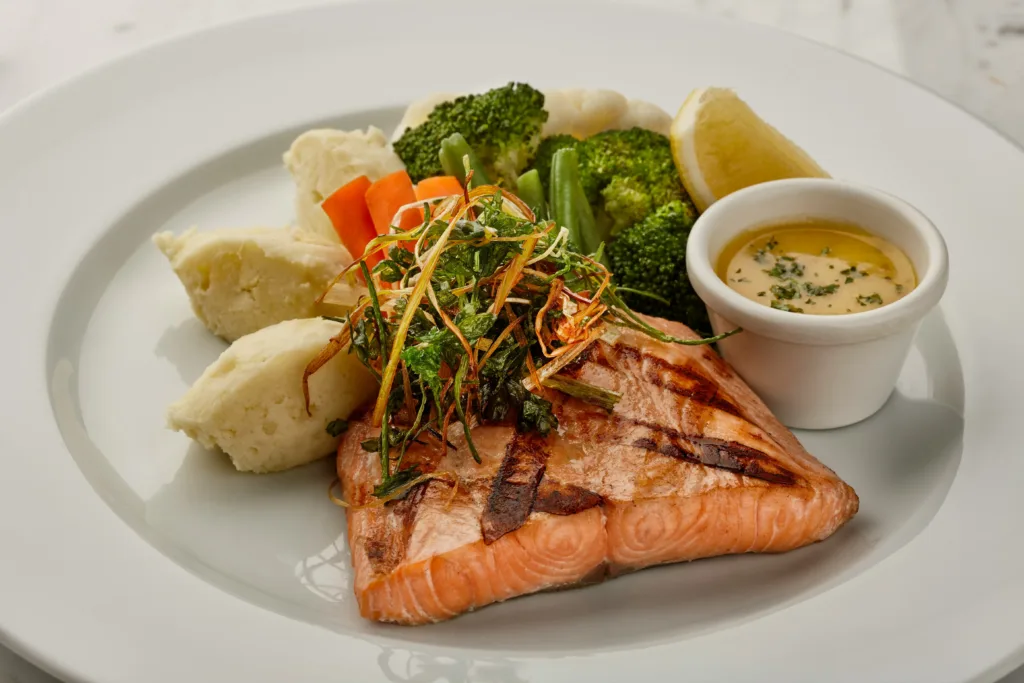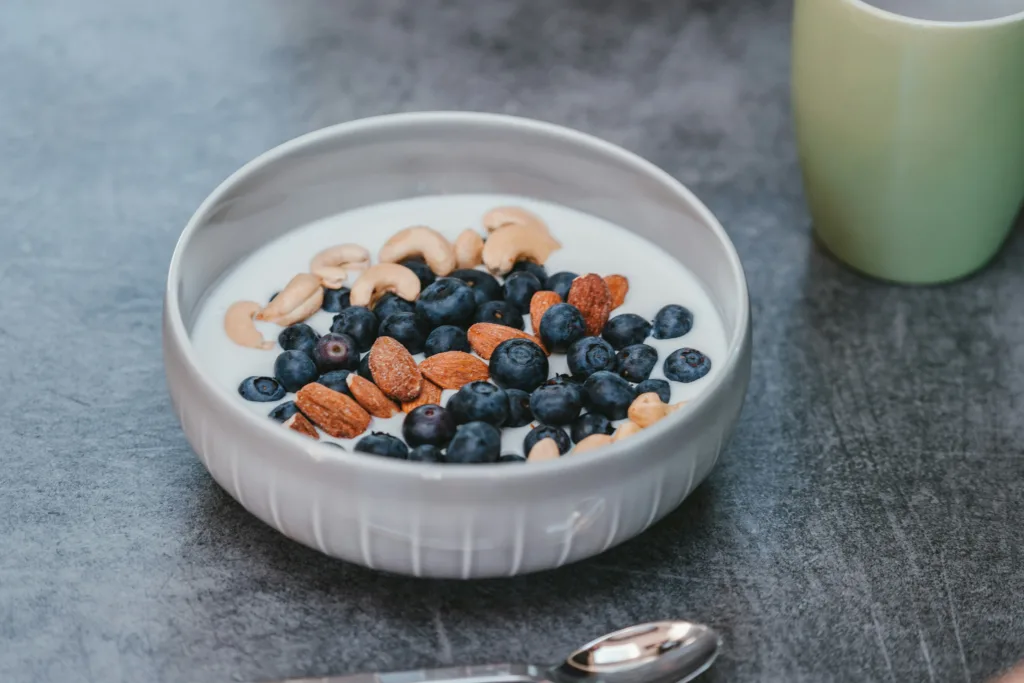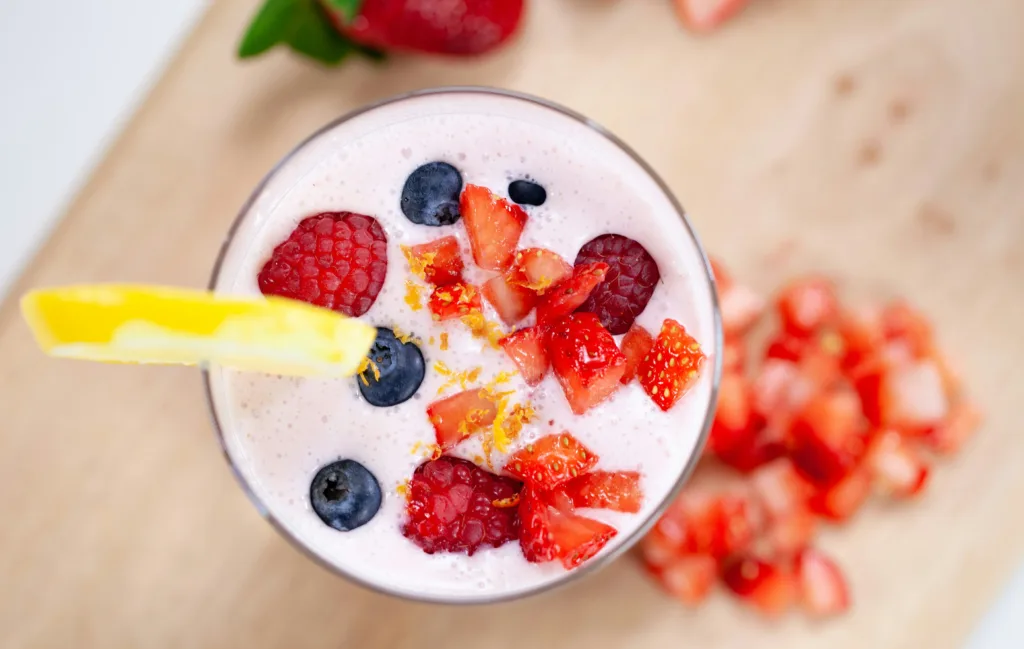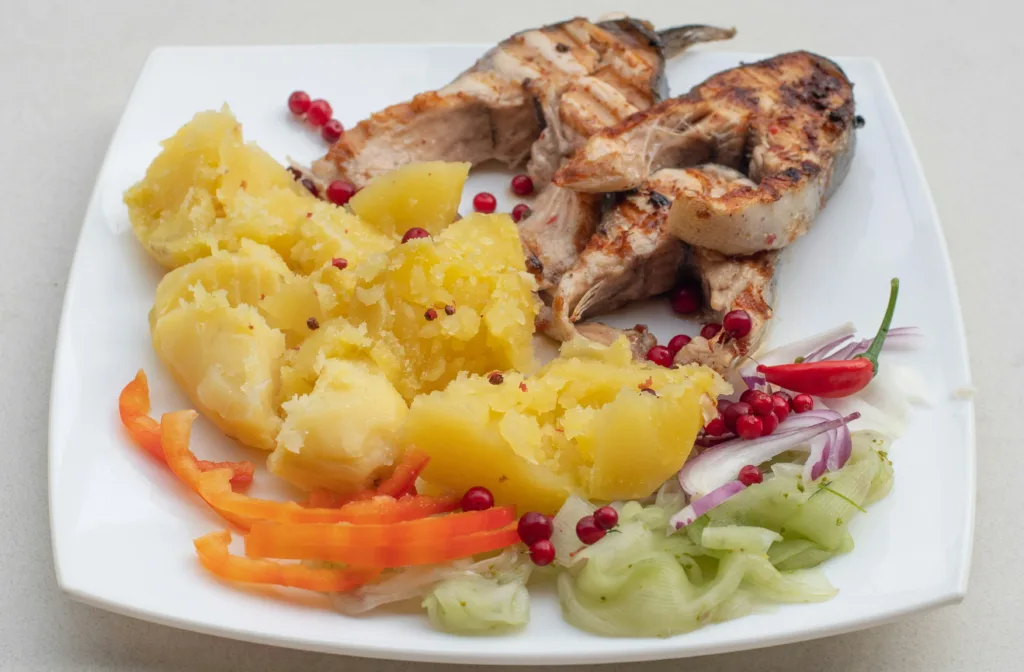If you’ve ever felt that burning sensation in your chest after a meal – yep, the one that creeps up and overstays its welcome – you’re not alone. Acid reflux is annoying at best, disruptive at worst, and often tied directly to what’s on your plate. The good news? You don’t have to overhaul your entire diet to start feeling better. This 7-day plan keeps things gentle, satisfying, and actually doable – no bland rice-only meals here.
At ReciMe, we’re all about making eating well feel easier, especially when your meals need to work with your body, not against it. Struggling to remember which foods trigger symptoms? Or tired of Googling “is yogurt okay for reflux?” every other day? Use ReciMe to save reflux-friendly recipes from anywhere – TikTok, Pinterest, your camera roll – and turn them into smart meal plans with aisle-sorted grocery lists that take the guesswork out of what to eat. Grab ReciMe now, take the pressure off your stomach and your planning.


What Is Acid Reflux (and How It Differs from GERD)?
Acid reflux happens when stomach acid sneaks back up into your esophagus – basically, the stuff that’s supposed to stay in your stomach decides to make a return trip. This can lead to that burning feeling in your chest (aka heartburn), a sour taste in your mouth, or just general discomfort after eating. It’s surprisingly common and often shows up after big meals, late-night snacks, or trigger foods like citrus or fried stuff.
Now, if acid reflux starts happening more often – like several times a week – it might be something more serious called GERD (short for gastroesophageal reflux disease). Think of GERD as acid reflux’s more persistent, less polite cousin. It can come with extra symptoms like coughing, trouble swallowing, or regurgitation, and usually needs a bit more than just dietary tweaks to manage. So while they’re closely connected, reflux and GERD aren’t exactly the same thing.

The Link Between Diet and Acid Reflux
Food plays a bigger role in acid reflux than most people realize. It’s not just what you eat – it’s how much, when, and even how fast you eat it. Certain foods can relax the valve that separates your stomach from your esophagus (yep, that’s the lower esophageal sphincter), making it easier for acid to sneak upward. Others just irritate things on contact. And then there’s the size of your meal – the fuller your stomach is, the more likely it is to push things the wrong way.
That’s why a solid reflux-friendly diet isn’t about being perfect – it’s about figuring out what foods trigger your symptoms and building meals that support digestion instead of fighting against it. Swapping fried foods for baked ones, skipping the late-night pizza, or even just eating a little slower can make a huge difference. Small changes add up, especially when they become habits you can actually stick with.
7-Day Meal Plan for Acid Reflux
When you’re dealing with acid reflux, food isn’t just food – it’s fuel and a potential trigger. This meal plan keeps it easy on your stomach while still feeling like real meals you’d actually want to eat. No sad steamed chicken here. Just a full week of low-acid, reflux-friendly breakfasts, lunches, dinners, and snacks that aim to calm your gut, not fire it up.
Let’s get into it – and remember, everyone’s triggers are a little different, so keep a food diary to identify your specific triggers and consult a healthcare provider if symptoms persist. Feel free to swap in ingredients you know your body loves.

Day 1 – Soft Start, Big Wins
Your stomach’s been through enough, so we’re starting off easy. Today’s meals are soft, balanced, and built around low-acid ingredients that support digestion and help you feel steady – no drama, just calm comfort.
- Breakfast: Banana oatmeal with almond milk, chia seeds, and a small drizzle of maple syrup (use sparingly, as excess sugar may trigger symptoms in some). A warm, gut-friendly start – oats help absorb stomach acid, and bananas soothe irritation while adding natural sweetness and potassium.
- Lunch: Grilled chicken quinoa bowl with steamed zucchini and a splash of olive oil. Light but filling, this combo gives you lean protein, fiber, and easy-to-digest veggies without triggering reflux or weighing you down.
- Snack: Rice cakes with low-fat yogurt and sliced pear. A satisfying crunch without the acid – almond butter adds healthy fat and creaminess, and pears bring gentle fiber and natural hydration.
- Dinner: Oven-baked white fish with mashed Yukon gold potatoes and sautéed green beans.
Day 2 – Gentle Variety Without the Guesswork
Brings a little more texture and color, but still keeps everything reflux-friendly and low on triggers. Think: soft proteins, mild veggies, and just enough flavor to keep things interesting without setting anything off.
- Breakfast: Spinach and egg scramble with whole grain toast. Eggs offer a gentle protein boost in the morning, and when paired with soft greens and a slice of plain toast, they give you fuel without the acid spike – just skip any hot sauce or ketchup.
- Lunch: Turkey wrap (skip avocado) with shredded carrots and cucumber in a toasted whole grain tortilla.
- Snack: Gala apple slices with plain nonfat Greek yogurt. Gala apples are low in acid and easy on the stomach, and plain yogurt gives you probiotics without the sugar or fat that can cause issues.
- Dinner: Herb-roasted chicken thighs with wild rice and oven-baked baby carrots. This is a comfort meal without the heaviness – tender chicken seasoned with thyme and parsley, mellow root veg, and whole grains to keep you full without the reflux aftermath.
Day 3 – Light, Clean, and Surprisingly Filling
Today’s meals lean on lighter proteins and low-acid produce to give your stomach a bit of a break while still keeping you full and energized. It’s the kind of day where you don’t need a nap after lunch – just steady, calm digestion.
- Breakfast: Low-acid fruit smoothie with banana, melon, and almond milk, plus a handful of spinach. This one’s cool, creamy, and gentle on your gut – no citrus, no dairy, just slow energy and soothing fiber to start the day right.
- Lunch: Grilled cod with steamed broccoli and brown rice, drizzled with olive oil. Lean fish like cod is easy to digest and low in fat, and paired with mild greens and whole grains, it makes a clean, reflux-safe midday meal.
- Snack: Sliced pear with a small handful of sunflower seeds. Sweet and crunchy in the right way – pears are low-acid and hydrating, and the seeds give a salty, healthy-fat hit that won’t stir up symptoms.
- Dinner: Ground turkey stir fry with bok choy, rice noodles, and a splash of low-sodium broth. No soy sauce, no spice – just mellow flavor, and tender veggies that won’t push your stomach’s limits.
Day 4 – Midweek Meals That Just Work
We’re in the middle of the week, so today’s all about simple wins – meals that come together easily, sit well, and give you energy without flare-ups. Nothing fancy, just food that feels good.
- Breakfast: Overnight oats with almond milk, chia seeds, and blueberries. You prep it once, and it’s ready in the morning – cool, fiber-packed, and kind to your stomach with no acidic surprises.
- Lunch: Warm quinoa bowl with sautéed zucchini, shredded carrots, kale, and a spoonful of black beans. This one’s hearty without being heavy, and seasoned with dried oregano and basil for flavor that won’t bite back.
- Snack: Homemade trail mix with banana chips, almonds, and pumpkin seeds. Just a handful gives you crunch, natural sweetness, and healthy fats – all without irritating your stomach lining.
- Dinner: Sheet pan chicken breast with fingerling potatoes and roasted asparagus, seasoned with thyme and a touch of olive oil. It’s one-pan comfort – nothing fried, nothing acidic, just balanced, oven-roasted goodness.

Day 5 – Comfort Food That Won’t Bite Back
We’re bringing back some familiar favorites today, but with a reflux-friendly spin. No tomato sauces, no vinegar dressings – just smart swaps that keep your meals cozy and calm.
- Breakfast: Plain nonfat Greek yogurt with honeydew melon and a sprinkle of low-fat, low-sugar granola. The yogurt gives you protein and probiotics without the fat, and the melon keeps it hydrating and low in acid – plus a little crunch never hurts.
- Lunch: Tuna sandwich made with plain Greek yogurt instead of mayo, served on whole grain bread with avocado, cucumber, and lettuce. It’s creamy, fresh, and satisfying without anything acidic sneaking in – no pickles, no tomato, no regrets.
- Snack: Carrot sticks with a small amount of low-fat yogurt dip (test tolerance, as high-fat dips may trigger reflux in some). Skipping the lemon juice keeps it reflux-friendly, and the combo hits that savory craving in a smooth, gentle way.
- Dinner: Turkey burger topped with sautéed spinach and mushrooms, served with roasted Brussels sprouts and sweet potato wedges. No bun needed if that’s a trigger – just solid protein and slow-digesting carbs that feel like a proper meal without the acid backlash.
Day 6 – Light Meals, Low Stress
Some days call for meals that don’t ask too much of your stomach – or your schedule. Today’s lineup is light, balanced, and super manageable, especially if you’re short on energy or appetite.
- Breakfast: Hard-boiled eggs with a toasted whole grain English muffin. It’s a no-fuss breakfast that gives you protein and fiber without any acidic extras – just keep toppings plain and skip the butter if needed.
- Lunch: Grilled chicken salad with romaine, avocado, cucumber, and olive oil + chopped fresh herbs. No vinegar here – just simple, refreshing ingredients that go down easy and still feel like a proper lunch.
- Snack: Rice crackers topped with avocado and chopped parsley. Creamy, salty, and satisfying with a clean crunch that doesn’t stir up reflux symptoms.
- Dinner: Grilled shrimp with couscous and sautéed spinach, finished with dill and a tiny drizzle of sesame oil. Light and flavorful, this one’s got protein, greens, and carbs without anything heavy or acidic tagging along.
Day 7 – Easy Wins to Wrap the Week
You made it to the end of the week, and your stomach deserves a pat on the back. Today’s meals are simple, feel-good options that are easy to throw together and even easier to digest.
- Breakfast: Banana smoothie with almond milk and a scoop of protein powder It’s creamy, filling, and caffeine-free – a solid morning pick-me-up that won’t stir up reflux.
- Lunch: Lentil soup made with vegetable broth (no tomatoes) and served with whole grain crackers. Warm and grounding, this combo gives you fiber, protein, and zero acidity – ideal if your stomach’s feeling a little sensitive.
- Snack: Fresh watermelon cubes topped with a sprinkle of low-fat feta or a non-dairy alternative. Hydrating and lightly salty-sweet, this snack feels like a treat without pushing your stomach’s limits.
- Dinner: Rotisserie chicken (skin removed) with brown rice and roasted green beans. A no-effort dinner that still checks the boxes – low-fat, balanced, and super gentle to end the day on a calm note.
Foods to Avoid with Acid Reflux
Let’s be honest – acid reflux has a way of turning even your favorite meals into a gamble. And while triggers can vary from person to person, some foods just tend to cause more chaos than calm. Here’s a breakdown of the usual troublemakers worth putting on pause (at least while you’re trying to get symptoms under control).
High-acid foods
Citrus fruits like oranges, lemons, and grapefruit might seem healthy, but the acid content can really mess with your esophagus. Tomato products – think pasta sauce, ketchup, salsa – are also big offenders, even in small amounts.
Spicy ingredients
Chili flakes, cayenne, hot sauces, and spicy curries can dial up acid production fast. If you’re missing flavor, lean on herbs like basil, parsley, and oregano instead – they add depth without the fire.
Fried and fatty foods
Deep-fried snacks, full-fat dairy, buttery sauces, and heavy meats can slow digestion and increase pressure in your stomach – a combo that invites reflux to show up uninvited.
Caffeine and carbonated drinks
Coffee, energy drinks, cola – all of these can relax the muscle that’s supposed to keep stomach acid in place. Even green and black tea can be problematic for some folks.
Alcohol
Wine, beer, cocktails… unfortunately, they’re all on the list. Alcohol can irritate your stomach lining and weaken your lower esophageal sphincter (the valve that keeps acid where it belongs).
Chocolate and mint
Yep, both can relax the esophageal valve too, especially when eaten on an empty stomach. It’s sneaky, but real – even a little bit of dark chocolate or peppermint tea can trigger symptoms in sensitive people.
Now, will every single one of these cause reflux for you? Maybe not. But if you’re trying to figure out what’s setting things off, it’s smart to start with these and work backward. Keep a mental note or jot things down – your future self (and your esophagus) will thank you.

Key Eating Habits That Help Prevent Reflux
It’s not just about what you eat – it’s also how you eat. Acid reflux doesn’t always show up because of one ingredient; sometimes, it’s more about timing, posture, and portion size. Here are a few everyday habits that can make a big difference – no medication required.
- Eat smaller meals more often: Big portions can stretch your stomach and push acid where it doesn’t belong. Smaller, spaced-out meals keep things manageable and reduce that post-meal pressure.
- Don’t lie down right after eating: We know – sometimes a food coma hits hard. But try to stay upright for at least 2-3 hours after eating. Gravity actually helps keep acid down where it should be.
- Slow down when you eat: It sounds basic, but scarfing down food can lead to overeating, gas, and – you guessed it – reflux. Chew thoroughly, take your time, and pause between bites.
- Ditch the late-night snacks: Eating right before bed can stir up symptoms when you’re horizontal for the night. If you’re hungry late, stick to something small and low-fat – or just prep a satisfying breakfast instead.
- Skip the tight waistbands: Clothes that press into your stomach (think high-waisted jeans, fitted belts) can put pressure on your gut and make reflux worse. If your clothes feel tight after a meal, your stomach probably agrees.
- Drink smart: Sipping water with meals is great, but chugging large amounts or downing fizzy drinks can create air bubbles that push acid upward. Go slow and stick to still beverages that don’t mess with your system.
Conclusion
Managing acid reflux doesn’t have to mean eating plain toast forever. With a little planning and some smart swaps, you can build meals that are satisfying, flavorful, and way easier on your stomach. This 7-day plan isn’t just about avoiding the bad stuff – it’s about finding meals you actually want to come back to. Whether you’re easing symptoms or just looking to feel better after eating, starting with calm, consistent meals can go a long way.
FAQ
1. Can I still eat carbs if I have acid reflux?
Absolutely – whole grains like oats, brown rice, quinoa, and whole grain bread are actually great for acid reflux. Just keep portion sizes in check and avoid piling on fatty toppings or acidic sauces.
2. Is dairy bad for acid reflux?
It depends on the type. Full-fat dairy can be a trigger for some people, but low-fat or nonfat options (like plain Greek yogurt or almond milk) are usually gentler. Trial and error helps here.
3. Can I drink coffee on this plan?
Coffee is one of the top reflux triggers due to its caffeine content. If you’re not ready to give it up completely, try cutting back or switching to decaffeinated herbal teas like chamomile or ginger, but test tolerance as some teas may still cause symptoms in sensitive individuals.
4. What fruits are safe to eat with acid reflux?
Stick to low-acid fruits like bananas, melons, pears, apples (Fuji or Gala), and even some berries. Citrus fruits – oranges, grapefruit, lemons – are best avoided when symptoms flare.
5. Do I have to cut out all spicy food forever?
Not necessarily. Some people can tolerate a little spice once symptoms improve, but during a flare-up it’s best to skip anything hot or peppery. Use herbs instead – oregano, thyme, and basil can bring flavor without the burn.
